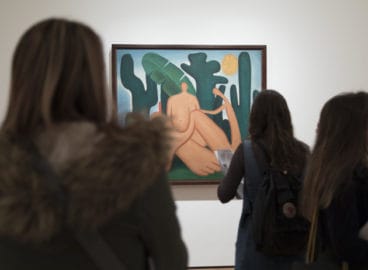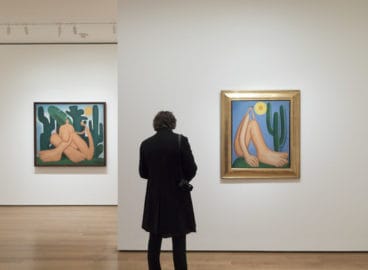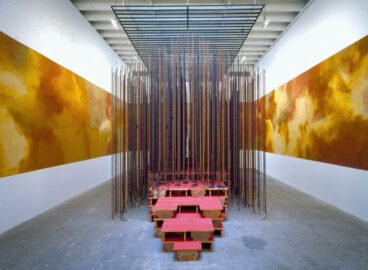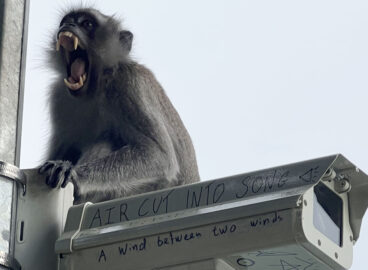This interview with Zarina considers the artist’s life and work as a bridge between New Delhi and New York, weaving together distinct temporalities and traditions of modernism and abstraction, and hereby potentially also challenging canonical histories of feminism and post-minimalism in the 1970s in New York.

In the May/June 1970 issue of Vrishchik,1Vrishchik (1969–73) is a Gujarati word that means “scorpion” and was an art journal founded and edited by Gulam Mohammed Sheikh and Bhupen Khakhar, artists who lived in Baroda and taught in the Faculty of Fine Arts at Baroda University. The participants in the conversation “On Printmaking” included the American artist and printmaker Paul Lingren and the Indian artists Jyoti Bhatt, Jeram Patel, Gulam Mohammed Sheikh, Bishambhar Khanna, Jagmohan Chopra, and Zarina. there is a conversation between six Indian printmakers in Delhi that includes the artist Zarina. “On Printmaking” was initiated by the editors of the journal, Gulam Mohammed Sheikh and Bhupen Khakhar, both well-known artists in their own rights, after a Smithsonian printmaking workshop in Delhi that they had all participated in. Zarina’s contributions to the conversation pivot around formal considerations regarding questions of color, variation, and reproduction in printmaking, and an insistence upon thinking of printmaking as a unique visual medium. This issue of Vrishchik includes an image of Zarina’s Cage (1970), a black-and-white relief print made from collaged wood, along with other prints by the Indian artists.
In 1979 Zarina, now in New York, was on the guest editorial staff of “Third World Women: The Politics of Being Other,” a special issue of the feminist publication Heresies. This editorial group included “painters, poets, educators, multi-media artists, students, shipbuilders, sculptors, playwrights, photographers, socialists, craftswomen, wives, mothers and lesbians.”2“Third World Women: The Politics of Being Other,” Heresies: A Feminist Publication on Art and Politics, issue 8, vol. 2, no. 4 (1979). Zarina was the only South Asian in the group, indicated by the descriptor in the editorial statement that describes an “Indian (from New Delhi).” Zarina’s cast-paper sculpture Wall (1979) was included in the issue, which she designed, along with images of artworks by Beverly Buchanan, Ana Mendieta, Betye Saar, and others that were interspersed between the essays and poetry.
Sadia Shirazi: What was it like being an artist in Delhi in the late 1960s and early 1970s?
Zarina: Delhi was very exciting in the seventies. There were lectures and discussions. I was living in Delhi when Nasreen [Mohamedi] came back from Kuwait or Bahrain and Tyeb Mehta came back from New York—he [Mehta] always loved books and movies—we’d go to Old Delhi and I’d buy paper.3Nasreen Mohamedi and Tyeb Mehta, artists and friends of Zarina, both lived in Delhi in the 1970s. Tyeb’s place was our adda.4An adda is a Hindi-Urdu-Bengali-Gujarati word that describes both a place for gathering and a long, informal conversation. When I first returned to Delhi from Paris, I brought a lot of paper with me—French paper, and BFK and all.5BFK is an acid-free moldmade printmaking paper from France. Then, in Delhi, I started studying the tradition we have, because the Indian market was feeding the colonies and people had no jobs, and our papermaking had gone down because it was cheaper to buy imported paper. So I started using handmade paper, Indian made from the Gandhi ashram.
SS: What did you like about the Indian handmade paper compared to the paper from France?
Z: It was very good quality; it was very even. I liked the rawness of it.
SS: I found these pamphlets for workshops where you taught papermaking at the New York Feminist Art Institute in the late seventies and eighties.
Z: By that time, I had decided that I would learn how to make paper and where it comes from, because I wanted to know more about the material. I know chemistry, so I knew paper is made from cotton. You make a pulp of it, and you put it in water. With a lot of water, you don’t need any glue—it’s called hydrogen bonding—but if I hadn’t studied chemistry, I wouldn’t have understood that. I think timing is everything. When I came here, there was the revolution in handmade paper—in Santa Cruz, in New York, all over the place, so the timing was right. I taught a class on the ABC’s of papermaking, and I suddenly thought, this material has the potential of being cast. Not a plaster cast or a shell. I had moved and I didn’t have space or money, so I devised my own mold with wood, and I took a plastic sheet and drilled holes in it so the paper would drain out and also take on the surface of the plastic, so it would shine. So, in the seventies, in New York, I made my first cast-paper sculpture.

SS: You were also part of the editorial collective of the Heresies “Third World Women: The Politics of Being Other” issue. You were the only South Asian woman but one of two Muslims, which wasn’t a category of interest as it is today and isn’t mentioned anywhere in the publication. It’s interesting how explicit your editorial group’s introduction is about the problems your collective had with the main Heresies collective, which is described in the introduction as “racist and paternalistic.”
Z: I always read the Heresies issue as being about third-class artists. We were not part of the first world because we were not Europeans, we were not white. We were communists and leftists. I really didn’t like the term third world. It felt like a negative designation . . . there was not one person of color in Heresies. Feminism for me was about equal pay for equal work—not about burning bras. Then they invited me to join the collective and I said no. They were horrible to me! I didn’t want to work for them.
SS: It’s not just you, as a person, who was unintelligible, I imagine, but also your work, which was quite distinct from the process-based “feminist” work coming from the Heresies collective at that time.
Z: They’d say my work is very abstract and very minimal. I didn’t know what minimal was. I’d never heard the term, because I didn’t go to an art school.
SS: You were also a co-curator of the exhibition Dialectics of Isolation: An Exhibition of Third World Women Artists in United States (1980) with Ana Mendieta and Kazuko Miyamoto at A.I.R. Gallery. You designed that catalogue, along with the Heresies one.
Z: Yes. Ana was part of A.I.R. Gallery. She wanted me to be part of it, too, but they didn’t want to have me. They thought I was an upper-class Indian [laughter].6Zarina’s father was a professor at Aligarh Muslim University and her mother was in purdah, which means that she was educated by teachers within the home and that she did not work outside of it. Zarina’s family home was in faculty housing on campus. She was educated in Urdu medium schools and then completed her undergraduate studies at Aligarh Muslim University in mathematics before being married and moving abroad with her husband, Saad Hashmi, a diplomat in the Indian Foreign Service. I took editing classes at the New School for the Heresies publication, to learn how to edit.
SS: I know that you had a network of friends in New York—from the Reddys, who had been in Paris with you, to Ram Rahman, who you knew from Delhi and who introduced you to Mehlli Gobhai.7Zarina met the Indian artist Krishna Reddy at Stanley William Hayter’s Atelier 17 in Paris in the 1960s, where Reddy had been working on color viscosity printing techniques with Hayter since the 1950s. The Metropolitan Museum of Art recently showed Reddy’s and Zarina’s work alongside that of their mentor in Workshop and Legacy: Stanley William Hayter, Krishna Reddy, Zarina Hashmi(2016–17). Ram Rahman is a photographer, curator, and activist from Delhi who was in New York in the seventies and eighties, as was Mehlli Gobhai, a painter from Bombay who also worked in advertising. Rahman and Gobhai both live in India. What did you do on Friday nights as a young artist in New York? Any memorable stories?
Z: For me, Friday evenings were for going to the Met. I could just see anything I wanted. All the guards knew me because they were all artists. Once on the Lower East Side, at Kenkeleba House, Judy [Reddy]8Judy Blum Reddy is an American artist and friend of Zarina, whom she first met in Paris in the 1960s. She is married to Krishna Reddy and they live together in New York. turned around and asked for a cigarette, and it was Philip Glass she asked! Then she said, “Oh, never mind.” [Laughter] Nobody was a star; you could run into people. People were accessible.
SS: When you move to the United States, your work grows in a certain sense from your dislocation. You bring things together in a way that has an uncanny effect; first you take the horizon from the etchings in Santa Cruz (1996), which you pair with Faiz Ahmad Faiz’s poetry, and reduce the horizon formally in Subh (Morning) and Raat (Night) from Home Is a Foreign Place (1999), a work that recalls everyday life in Aligarh.9Faiz Ahmad Faiz (1911–1984), born in British India, was a renowned poet, writer, intellectual, and left-wing activist from Pakistan.

Z: In Santa Cruz, there was a beautiful sunset on Monterey Bay, and the lights going up—twilight they call it—it was so beautiful.10Zarina taught printmaking at the University of California, Santa Cruz, from 1992 to 1997. Then I thought of Faiz’s “kai baar us ka daaman bhar diya husn-e-do aalam se” and then there is a misra, “magar dil hai ki us ki khana virani nahin jaati,”11A misra is a line in Urdu poetry. This poetry by Faiz Ahmad Faiz loses much of its meaning in translation but a rough translation is “How often it is filled with the beauty of both worlds, and yet the emptiness of my heart remains.” which is in the Santa Cruz portfolio. I wanted to do ten but time was running out and so I just did this one, Santa Cruz (1996).
SS: In your work from the late 1970s in New York, you begin to explore space, sculpture, and materiality, the untitled pin drawings, your cast-paper sculptures, and then your bronze sculptures . . .
Z: The space—I wouldn’t have known if I didn’t go into sculpture—that helped me. Until I did this sculpture [points to bronze sculpture on wall]—I did it in New York.
SS: Your work makes a lot of use of modes of spatial representation, from aerial maps of cities to architectural floor plans. How did you begin working with maps?
Z: I had a small map from an atlas, and I blew it up. I’ve always been interested in geography and how cities are laid out. My father took me on a joyride in a plane over Aligarh when I was a child, and I saw how the city was laid out. I sat in his lap—it must have still been during British India. I flew a glider later, myself, in Delhi.
SS: I know you wanted to study architecture as a child and have had a lifelong interest in it. Do you have a favorite building in India?
Z: Yes. I was always interested in architecture. I love Fatehpur Sikri and Humayun’s Tomb more than the Taj Mahal. My favorite, though, is Sanchi in Madhya Pradesh, the Buddhist stupa. It is so pure that you think it was made yesterday. Forget Chandigarh.
SS: Although you have often said that in your work words come first, before the image, Dividing Line has no words and is such a powerful piece. I mentioned in your panel discussion at NYU this past November how you gouged the wood block, how you carved the entire ground of the image as opposed to the line, and I think this haptic sensibility of yours has something to do with the difficulty of visual representation and partition.12Zarina is the 2017–18 artist in residence at the Asian/Pacific/American Institute (A/P/A) at New York University, which included talks and a panel discussion on the artist and the works in her exhibition, Zarina: Dark Roads (2017–18) at the A/P/A gallery. Sadia Shirazi, “Zarina: Dark Roads” (talk, Asian/Pacific/American Institute, New York University, New York, NY, November 1, 2017).

Z: I left Aligarh in 1958. That was the last time I lived in my country, in a home with my family, with my language, and I didn’t realize that once I stepped out, I’d never go back. So, when I came here, I made a promise to myself that when I retire, I will go back to woodcuts, and the first thing I did was Dividing Line. With woodcut, generally, you see it is black and people do white lines through it, but this line stands out. And the line I cut by hand with an electric tool . . . yes, it has no words.
SS: I feel like Dividing Line expresses the afterlife of partition—not just the violence of it as an event, but also its continuing aftereffects, which you and your family experienced. We often discuss your relationship to India, which is as vexed as India’s relationship to its minorities, and post-Babri, post-Gujarat, and post-Modi, particularly Muslims.13The Babri Masjid was a sixteenth-century mosque in Ayodhya, Uttar Pradesh (U.P.), that was destroyed in December 1992 by Hindu kar sevaks, activists who attended a rally organized by the Bharatiya Janata Party (BJP), a Hindutva party closely linked to the Hindu nationalist Rashtriya Swayamsevak Sangh (RSS) and the Vishva Hindu Parishad (VHP), a far-right Hindu nationalist organization. The destruction of the masjid occurred in the wake of the BJP leader L. K. Advani’s “Ram Rath Yatra,” a march that agitated for the erection of a Ram temple on the contested site of the birthplace of Ram, at the site of the mosque. The destruction of the mosque in Ayodhya ignited street protests and communal tension throughout India and destabilized neighboring Pakistan and Bangladesh with retaliation riots. The event marks the formal beginning of the continuous rise of right-wing Hindutva and anti-Muslim violence—the Bombay riots in 1992, the massacre in Gujarat in 2002, among others—all culminating in the election of far-right BJP leader Narendra Modi in 2014. I imagine all of this is something that took time to unfold and that you could only express it with some distance.

Z: I think that I revisited partition when I came here and then I suddenly thought, what have I done to my life. In the big picture, my story is nothing. There are stories of people who got slaughtered, and women who were raped, but it’s not all Manto’s “Thanda Gosht” and “Toba Tek Singh,”14Saadat Hasan Manto (1912–1955) was a writer and playwright, best known for his short stories in Urdu. He was born in British India and immigrated to Lahore after partition. Thanda Gosht (Cold Meat, 1950) and Toba Tek Singh (1955), whose title takes its name from the suddenly divided town, are two famous stories he wrote about the violence and absurdity of partition. and so we are not important, but we are witnesses.
When I did Letters from Home, I also thought that in thirty years someone will look at them and see we wrote them, the letters, in Urdu, because my mother didn’t know English, so of course I wrote to her in Urdu. At home we never spoke English. It was considered very rude to speak English when people didn’t understand, so we all spoke in Urdu. Suppose I hadn’t left. I don’t know where I would be now . . . but I wanted to leave. I wanted to see the world. And traveling is our destiny—“sitaron se aage jahan aur bhi hain”—as a child, we were supposed to memorize and I memorized Iqbal.15Sir Muhammad Iqbal (1877–1938), also known as Allama Iqbal, was a poet, philosopher, academic, and lawyer. “Sitaron se aage jahan aur bhi hain” translates “Other worlds exist beyond the stars.” “Abhi ishq ke imtihan aur bhi hain” translates “More tests of love are yet to come.” [Recited together] “Abhi ishq ke imtihan aur bhi hain.”
- 1Vrishchik (1969–73) is a Gujarati word that means “scorpion” and was an art journal founded and edited by Gulam Mohammed Sheikh and Bhupen Khakhar, artists who lived in Baroda and taught in the Faculty of Fine Arts at Baroda University. The participants in the conversation “On Printmaking” included the American artist and printmaker Paul Lingren and the Indian artists Jyoti Bhatt, Jeram Patel, Gulam Mohammed Sheikh, Bishambhar Khanna, Jagmohan Chopra, and Zarina.
- 2“Third World Women: The Politics of Being Other,” Heresies: A Feminist Publication on Art and Politics, issue 8, vol. 2, no. 4 (1979).
- 3Nasreen Mohamedi and Tyeb Mehta, artists and friends of Zarina, both lived in Delhi in the 1970s.
- 4An adda is a Hindi-Urdu-Bengali-Gujarati word that describes both a place for gathering and a long, informal conversation.
- 5BFK is an acid-free moldmade printmaking paper from France.
- 6Zarina’s father was a professor at Aligarh Muslim University and her mother was in purdah, which means that she was educated by teachers within the home and that she did not work outside of it. Zarina’s family home was in faculty housing on campus. She was educated in Urdu medium schools and then completed her undergraduate studies at Aligarh Muslim University in mathematics before being married and moving abroad with her husband, Saad Hashmi, a diplomat in the Indian Foreign Service.
- 7Zarina met the Indian artist Krishna Reddy at Stanley William Hayter’s Atelier 17 in Paris in the 1960s, where Reddy had been working on color viscosity printing techniques with Hayter since the 1950s. The Metropolitan Museum of Art recently showed Reddy’s and Zarina’s work alongside that of their mentor in Workshop and Legacy: Stanley William Hayter, Krishna Reddy, Zarina Hashmi(2016–17). Ram Rahman is a photographer, curator, and activist from Delhi who was in New York in the seventies and eighties, as was Mehlli Gobhai, a painter from Bombay who also worked in advertising. Rahman and Gobhai both live in India.
- 8Judy Blum Reddy is an American artist and friend of Zarina, whom she first met in Paris in the 1960s. She is married to Krishna Reddy and they live together in New York.
- 9Faiz Ahmad Faiz (1911–1984), born in British India, was a renowned poet, writer, intellectual, and left-wing activist from Pakistan.
- 10Zarina taught printmaking at the University of California, Santa Cruz, from 1992 to 1997.
- 11A misra is a line in Urdu poetry. This poetry by Faiz Ahmad Faiz loses much of its meaning in translation but a rough translation is “How often it is filled with the beauty of both worlds, and yet the emptiness of my heart remains.”
- 12Zarina is the 2017–18 artist in residence at the Asian/Pacific/American Institute (A/P/A) at New York University, which included talks and a panel discussion on the artist and the works in her exhibition, Zarina: Dark Roads (2017–18) at the A/P/A gallery. Sadia Shirazi, “Zarina: Dark Roads” (talk, Asian/Pacific/American Institute, New York University, New York, NY, November 1, 2017).
- 13The Babri Masjid was a sixteenth-century mosque in Ayodhya, Uttar Pradesh (U.P.), that was destroyed in December 1992 by Hindu kar sevaks, activists who attended a rally organized by the Bharatiya Janata Party (BJP), a Hindutva party closely linked to the Hindu nationalist Rashtriya Swayamsevak Sangh (RSS) and the Vishva Hindu Parishad (VHP), a far-right Hindu nationalist organization. The destruction of the masjid occurred in the wake of the BJP leader L. K. Advani’s “Ram Rath Yatra,” a march that agitated for the erection of a Ram temple on the contested site of the birthplace of Ram, at the site of the mosque. The destruction of the mosque in Ayodhya ignited street protests and communal tension throughout India and destabilized neighboring Pakistan and Bangladesh with retaliation riots. The event marks the formal beginning of the continuous rise of right-wing Hindutva and anti-Muslim violence—the Bombay riots in 1992, the massacre in Gujarat in 2002, among others—all culminating in the election of far-right BJP leader Narendra Modi in 2014.
- 14Saadat Hasan Manto (1912–1955) was a writer and playwright, best known for his short stories in Urdu. He was born in British India and immigrated to Lahore after partition. Thanda Gosht (Cold Meat, 1950) and Toba Tek Singh (1955), whose title takes its name from the suddenly divided town, are two famous stories he wrote about the violence and absurdity of partition.
- 15Sir Muhammad Iqbal (1877–1938), also known as Allama Iqbal, was a poet, philosopher, academic, and lawyer. “Sitaron se aage jahan aur bhi hain” translates “Other worlds exist beyond the stars.” “Abhi ishq ke imtihan aur bhi hain” translates “More tests of love are yet to come.”





